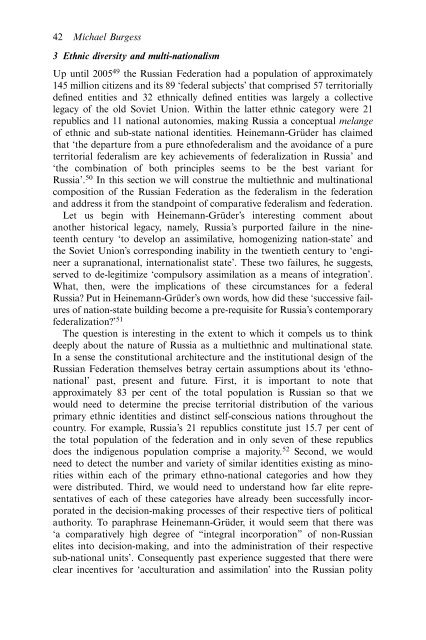Federalism and Local Politics in Russia
Federalism and Local Politics in Russia
Federalism and Local Politics in Russia
You also want an ePaper? Increase the reach of your titles
YUMPU automatically turns print PDFs into web optimized ePapers that Google loves.
42 Michael Burgess3 Ethnic diversity <strong>and</strong> multi-nationalismUp until 2005 49 the <strong>Russia</strong>n Federation had a population of approximately145 million citizens <strong>and</strong> its 89 ‘federal subjects’ that comprised 57 territoriallydef<strong>in</strong>ed entities <strong>and</strong> 32 ethnically def<strong>in</strong>ed entities was largely a collectivelegacy of the old Soviet Union. With<strong>in</strong> the latter ethnic category were 21republics <strong>and</strong> 11 national autonomies, mak<strong>in</strong>g <strong>Russia</strong> a conceptual melangeof ethnic <strong>and</strong> sub-state national identities. He<strong>in</strong>emann-Grüder has claimedthat ‘the departure from a pure ethnofederalism <strong>and</strong> the avoidance of a pureterritorial federalism are key achievements of federalization <strong>in</strong> <strong>Russia</strong>’ <strong>and</strong>‘the comb<strong>in</strong>ation of both pr<strong>in</strong>ciples seems to be the best variant for<strong>Russia</strong>’. 50 In this section we will construe the multiethnic <strong>and</strong> mult<strong>in</strong>ationalcomposition of the <strong>Russia</strong>n Federation as the federalism <strong>in</strong> the federation<strong>and</strong> address it from the st<strong>and</strong>po<strong>in</strong>t of comparative federalism <strong>and</strong> federation.Let us beg<strong>in</strong> with He<strong>in</strong>emann-Grüder’s <strong>in</strong>terest<strong>in</strong>g comment aboutanother historical legacy, namely, <strong>Russia</strong>’s purported failure <strong>in</strong> the n<strong>in</strong>eteenthcentury ‘to develop an assimilative, homogeniz<strong>in</strong>g nation-state’ <strong>and</strong>the Soviet Union’s correspond<strong>in</strong>g <strong>in</strong>ability <strong>in</strong> the twentieth century to ‘eng<strong>in</strong>eera supranational, <strong>in</strong>ternationalist state’. These two failures, he suggests,served to de-legitimize ‘compulsory assimilation as a means of <strong>in</strong>tegration’.What, then, were the implications of these circumstances for a federal<strong>Russia</strong>? Put <strong>in</strong> He<strong>in</strong>emann-Grüder’s own words, how did these ‘successive failuresof nation-state build<strong>in</strong>g become a pre-requisite for <strong>Russia</strong>’s contemporaryfederalization?’ 51The question is <strong>in</strong>terest<strong>in</strong>g <strong>in</strong> the extent to which it compels us to th<strong>in</strong>kdeeply about the nature of <strong>Russia</strong> as a multiethnic <strong>and</strong> mult<strong>in</strong>ational state.In a sense the constitutional architecture <strong>and</strong> the <strong>in</strong>stitutional design of the<strong>Russia</strong>n Federation themselves betray certa<strong>in</strong> assumptions about its ‘ethnonational’past, present <strong>and</strong> future. First, it is important to note thatapproximately 83 per cent of the total population is <strong>Russia</strong>n so that wewould need to determ<strong>in</strong>e the precise territorial distribution of the variousprimary ethnic identities <strong>and</strong> dist<strong>in</strong>ct self-conscious nations throughout thecountry. For example, <strong>Russia</strong>’s 21 republics constitute just 15.7 per cent ofthe total population of the federation <strong>and</strong> <strong>in</strong> only seven of these republicsdoes the <strong>in</strong>digenous population comprise a majority. 52 Second, we wouldneed to detect the number <strong>and</strong> variety of similar identities exist<strong>in</strong>g as m<strong>in</strong>oritieswith<strong>in</strong> each of the primary ethno-national categories <strong>and</strong> how theywere distributed. Third, we would need to underst<strong>and</strong> how far elite representativesof each of these categories have already been successfully <strong>in</strong>corporated<strong>in</strong> the decision-mak<strong>in</strong>g processes of their respective tiers of politicalauthority. To paraphrase He<strong>in</strong>emann-Grüder, it would seem that there was‘a comparatively high degree of “<strong>in</strong>tegral <strong>in</strong>corporation” of non-<strong>Russia</strong>nelites <strong>in</strong>to decision-mak<strong>in</strong>g, <strong>and</strong> <strong>in</strong>to the adm<strong>in</strong>istration of their respectivesub-national units’. Consequently past experience suggested that there wereclear <strong>in</strong>centives for ‘acculturation <strong>and</strong> assimilation’ <strong>in</strong>to the <strong>Russia</strong>n polity
















